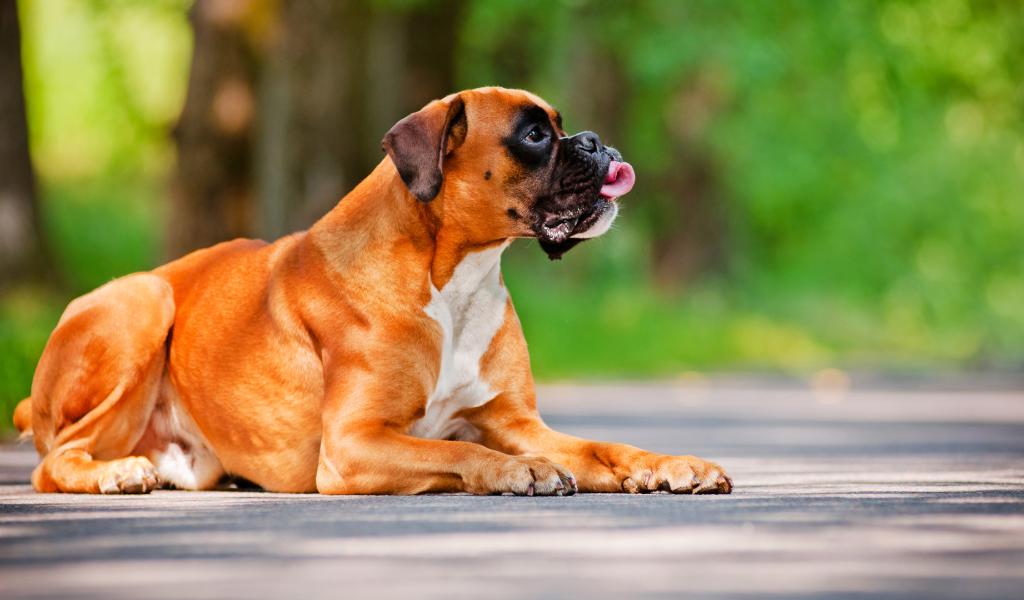The German boxer, bred in Germany, is known throughout the world and is considered one of the most popular breeds. Created as a service dog, the boxer continues to work today in special units of the army and police, and does a good job of being a guide, bodyguard and guard dog.
On the other hand, the docile nature of the boxer makes it possible to keep the dog in a family with small children. The Boxer is easy to educate and train, growing up as a devoted and affectionate friend. Loves attention, friendly and sociable. German boxers are medium-sized dog breeds with an average lifespan of 9-12 years.

The boxer breed appeared relatively recently. At the end of the 19th century, the first record of the origin of the breed was officially registered in the boxer stud book. The progenitors of the new breed at the end of the century before last were the small Brabant bullenbeisers, which were used by Europeans as hunting dogs. The breed was distinguished by courage and strength, capable of holding prey that exceeded the weight of the dog itself before the hunter appeared.
A wide mouth with a powerful shortened jaw held the prey, and the upturned nose helped to breathe during the grip even through the thick fur of the animal. Bullenbeisers possessed not only strength, but also the ability to quickly dodge. Similar qualities are characteristic of a boxer. With the advent of firearms and the disappearance of large animals in Europe, bullenbeisers began to be less bred and mixed with local dogs of other breeds, thus obtaining dogs that were more mobile and undersized.
The selection of dogs for breeding boxers was carried out according to working qualities, there were few purebred bullenbeisers left, there were many mestizos, who were often called “boxel”. In 1893, the German Kennel Club registered all available dogs, regardless of their breed, in a studbook. Friedrich Robert, Elard Koenig and Rudolf Hepner launched a campaign to promote the Boxer as an ideal military and service dog, and in 1895 they presented the first dog at an exhibition and stood at the origins of the Boxer Club. This year is considered the date of origin of the breed.
After the first standard, registered in 1902, the breed was edited several times. So, for example, in 1925 it was forbidden to breed boxers with a white color so that the dog was less noticeable in the war or while serving in the police. In 2002, the new standard included a ban on docking the ears and tail of a boxer, which is still in effect in some countries. In 2008, the final standard was adopted, which is valid to this day.
Breed characteristics
Boxers have a slightly intimidating appearance, but the character of the dogs of this breed is quite balanced. Boxers are calm and not prone to aggression. Excessive manifestation of aggression is considered a marriage of the breed. At the same time, fearless boxers are ready to protect their owners and perfectly cope with the role of a guard.
Dogs of this breed are cheerful and energetic. They love to walk, play and exercise. Boxers are suitable for families with small children. They are patient with the pranks of kids, love to spend time with them and play. Boxers can be safely left alone at home with children.
The German boxer retained the qualities of a hunter. In order to prevent the dog from rushing for a walk after small animals, for example, after cats, it is worth paying special attention to developing obedience and calm behavior in front of other animals. Representatives of this breed love the attention of the owner, they can hardly endure loneliness.
Upbringing
Boxers are highly intelligent and train well. At the same time, it is worth starting education and training from the moment the puppy appears in the house. To begin with, the pet needs to master the basic commands: “Sit”, “Lie down”, “Come to me”. Then, as you learn, add other commands: “Place”, “No”, “Fu”, “Next”.

When raising a puppy, adhere to several important points and rules:
- Start training after the puppy gets used to the new home,
- Allocate places at home for resting and feeding the dog, accustom the puppy to these places.
- As soon as the post-vaccination quarantine is over and the parasite treatment is done, start teaching your puppy to go to the toilet outside while walking.
- Praise the dog for the correct execution of commands, create a friendly atmosphere during training and reward with treats.
- Do not punish the puppy for refusing to follow commands, do not hit the dog or yell at it.
Little puppies can’t handle long sessions. Finish training before the puppy gets tired and loses interest in the lesson.
Boxers may not immediately follow new commands or rules, they need time to process the information. Be firm in your demands, be patient and reinforce what you have learned regularly. In parallel with the commands and before you start walking, the puppy is taught to the collar and leash.

